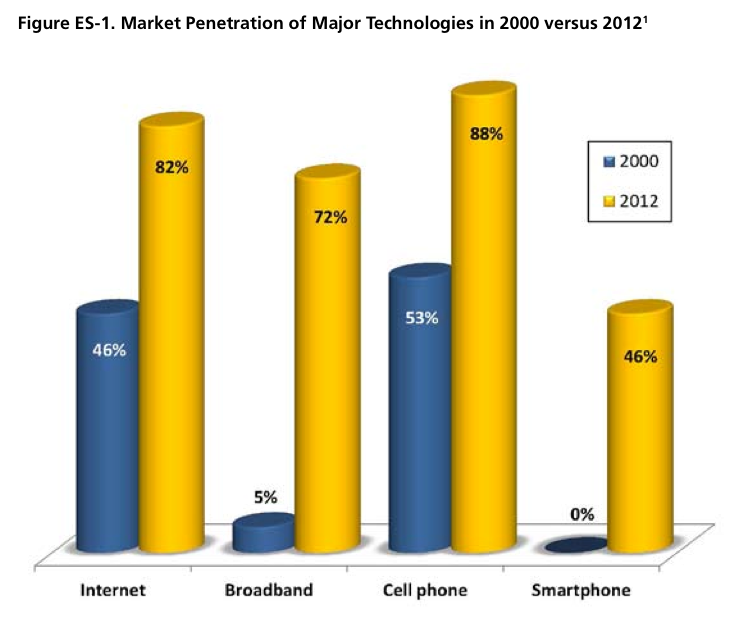FRONTIER GROUP
U.S. PIRG EDUCATION FUND
Executive Summary
America is in the midst of a technological revolution … and a big shift in our transportation habits.
Over the last 15 years, the Internet and mobile communications technologies have transformed the way Americans live and work. During that same period, growth in vehicle travel slowed and then stopped, with Americans today driving about as much on average as we did in 1996.
Both changes have taken place most rapidly among young Americans, who have been the earliest and most enthusiastic adopters of new technologies, as well as the new social networking tools that are the foundation of the emerging “sharing economy.” They have also been the group that has reduced its driving the most, with the average American between 16 and 34 years of age driving a startling 23 percent less in 2009 than in 2001.
Could these developments—the rapid spread of mobile, Internet-connected technologies, the emergence of social networking, and the recent decline in driving—be related? And what does the future hold?
Early evidence suggests that new innovations in technology and social networking are beginning to change America’s transportation landscape. New transportation services are providing people with an abundance of new options, helping to overcome barriers to the use of non-driving forms of transportation, and shifting the economics behind individuals’ travel choices. Collectively, they are also opening up the opportunity for more Americans to adopt “car-free” and “car-light” lifestyles with dramatically less driving.
America is in the midst of a technological revolution.
- Between 2000 and 2012, the percentage of adults who use the Internet increased from 46 percent to 82 percent. The percentage of adults who own a cell phone increased from 53 percent to 88 percent. The share of Americans with access to high-speed Internet at home increased from 5 percent to more than 70 percent. And roughly half of Americans now own smartphones, which did not exist in their modern form in 2000.
- These technologies are changing how Americans live and work. Participation in telework and e-commerce has increased dramatically in the last decade. Meanwhile, social networking has helped unleash an emerging “sharing economy.”
- Young Americans have consistently been the first to adopt and test the capabilities of these new technologies and practices. As of September 2012, young adults were six times more likely to have a smartphone than people in their grandparents’ generation, and twice as likely as those between 50 and 64 years of age.
Read full report (PDF) here: A New Way to Go
About the Frontier Group
www.frontiergroup.org
“Frontier Group conducts research and policy analysis to support a cleaner, healthier and more democratic society. Our mission is to inject accurate information and compelling ideas into public policy debates at the local, state and federal levels. For more information about Frontier Group, please visit our website at www.frontiergroup.org.”
About U.S. PIRG Education Fund
uspirgedfund.org
“With public debate around important issues often dominated by special interests pursuing their own narrow agendas, U.S. PIRG Education Fund offers an independent voice that works on behalf of the public interest. U.S. PIRG Education Fund, a 501(c)(3) organization, works to protect consumers and promote good government. We investigate problems, craft solutions, educate the public, and offer Americans meaningful opportunities for civic participation. For more information, please visit our website at uspirgedfund.org.”
Tags: A New Way to Go, Frontier Group, generational gap, Smartphones, U.S. PIRG Education Fund







 RSS Feed
RSS Feed